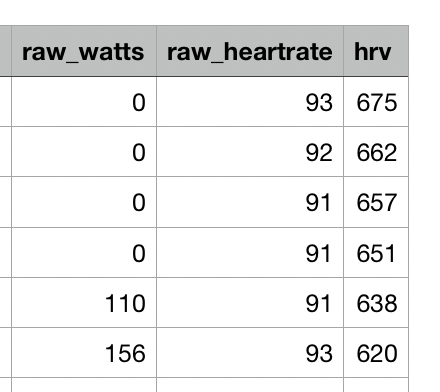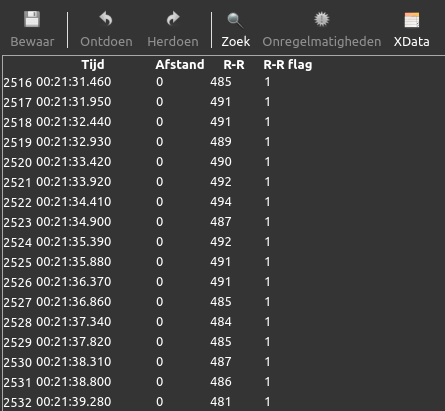This could be helpfull if your Edge 130 does not record HRV out of the box:
Under the picture of the watch there is a link to github with a fit file that is supposed to activate HRV on older watches. May also work on your Edge 130.
This could be helpfull if your Edge 130 does not record HRV out of the box:
Under the picture of the watch there is a link to github with a fit file that is supposed to activate HRV on older watches. May also work on your Edge 130.
Tx guys. I think I will get a Polar H10 and see.
Awesome, I really like my Oura ring. Also nice to be able to wear a non-sports watch every once in a while without going through data withdrawal!!
How thick does the Oura feel on your finger? My wedding band is on the thicker side and I haven’t worn it since our wedding day; Enso silicon instead.
Would consider an Oura but don’t know if I deal with the thickness.
I still know it’s there but its not bugging me much. Before this I didn’t wear any ring. If you can get the sizing kit from someone you can try that. The plastic rings in the kit are the same size as the real thing.
Tx. I copied this file into my NEWFILES folder on my Garmin Edge 130+, synced with GC on my phone, restarted the Garmin and it worked.
I have an easy 2h ride today so will look at that data.
Nice!
Wahoo Roam can record HRV???
I’ve been measuring my HRV using three different apps (Android HRV4, Elite and Kubios of late: I never enter any “how do you feel today” info) as well as the amazing Kubios PC program for several years. Unfortunately I was out of things for a year due to a shoulder injury but I do use my HRV measurements to guide my training/ life intensity. If numbers are low, I go easy - a brisk walk, not jog (zone 2 stuff). For my bike, similar. And that’s my health/ training plan. The chart makes a lot of sense: though the ‘low’ and ‘high’ intensities may be better represented by ‘higher’ and ‘lower’.
*kubios app is fast becoming my favourite
**Decathlon store hr monitor works well, despite what some app-owners say, and is very cost effective.
I did the sam with my forerunner 735 and it worked too. I just need to get a decent HR strap now as the data quality from my old garmin one is shocking!
Intervals.icu now pulls HRV data out of .fit files if it is present. It doesn’t do anything with it yet but you can download it via the “Ride CSV” link on the activity data page. It’s not the same as the other streams in that it isn’t tied to the time stream. Its just a long list of “milliseconds between beats”.

Hi David
Is that the RR data stream from a fit file? If so I’ve done a bit of work on understanding this I can share with you.
Cheers
John
Thanks! Yes it is exactly that just in milliseconds. I have been looking at some of the DFA alpha 1 stuff. I will definitely ping you when I can get back to it. Right now this whole Garmin thing has pushed Dropbox to the top of the heap. But that shouldn’t take too long.
DFA a1 to get an accurate AT could really push intervals ahead of the competition and open up some great analysis opportunities. It doesn’t look like it should be too complex, although the hardware is still lacking somewhat.
Looking at that stream in Golden Cheetah, the timeline is made-up by adding all RR intervals. Which after all is logical but I don’t know how to handle missed beats. A missed beat would give a high RR interval and should be filtered out.

In the posts I have seen about this people us a ±25% or ±5% filter comparing each interval to the previous one to filter out artefacts. Apparently all of this stuff is very sensitive to artefacts.
Yes, still very much in the experimental stage. At one point Marco Altini was planning on building an app specifically to measure DFA a1 and report your LT1. He was going to call it HRV4Threshold. When I spoke with him he said he was putting it on hold given the challenges being uncovered with this approach. So many confounding factors. He was going to wait and see.
No, @Olly_Thomas - I use HRVLogger as well. This was another app he had planned to build specifically for DFA a1 measurement. He’s waiting for the work to mature and for those researching it to get a clear understanding of the factors that influence it. It’s worth remembering that the correlation between LT1 HR and a DFA a1 of 0.75 is purely coincidental - there is no physiological cause for it. Hence the need for much more experimentation / investigation and analysis.
I’ve never had much luck tying this to training (or how I’m feeling for that matter). I do tend to pay attention if I notice a downward trend over time though.
That HRV data as part of a workout… what apps / devices record that?